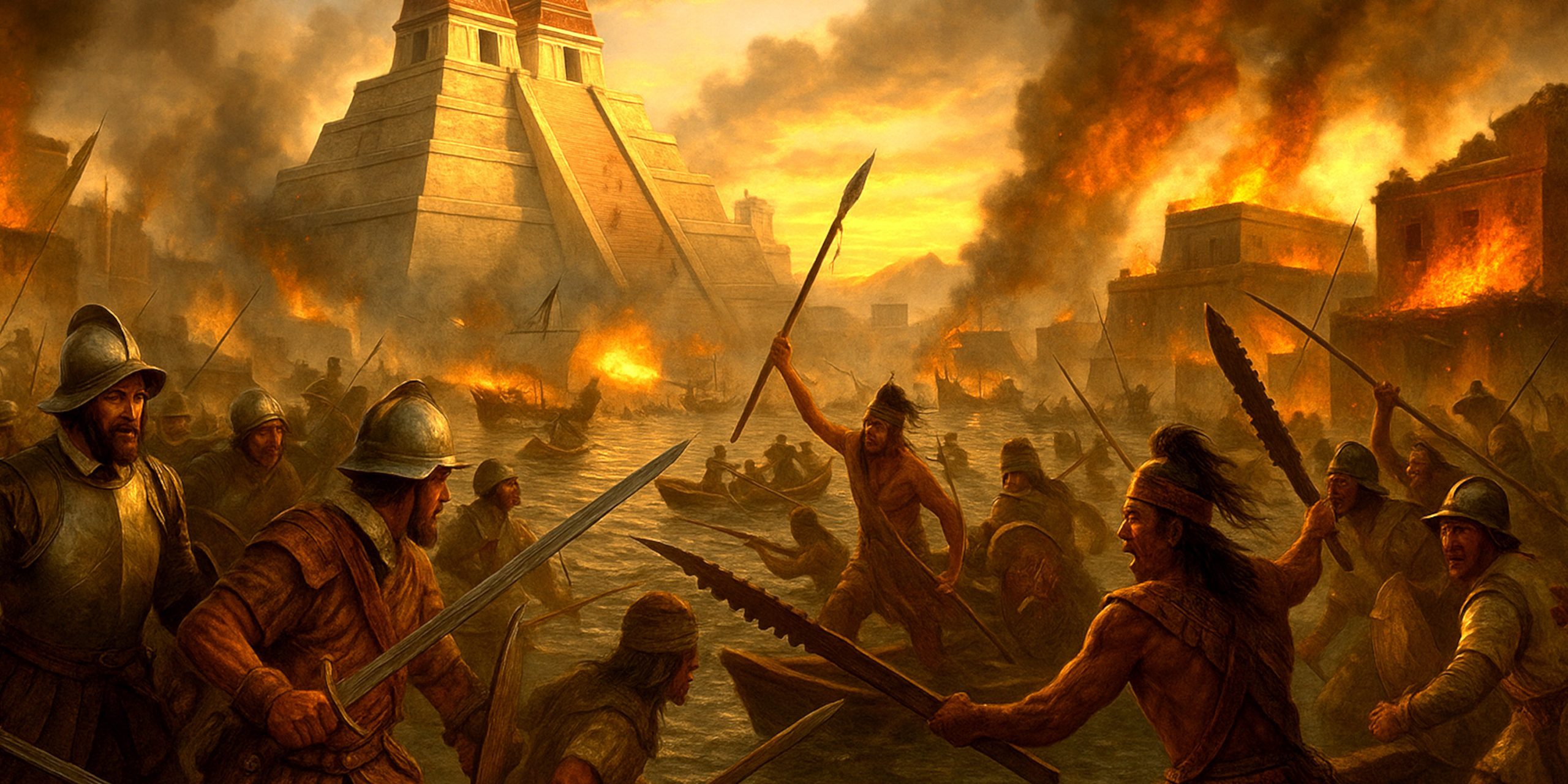
The fall of Tenochtitlan in 1521 marked the end of the Aztec Empire and the dawn of Spanish rule in Mesoamerica. It remains one of history’s most staggering reversals of fortune: an advanced and disciplined civilisation brought to its knees by a few hundred foreigners, aided by native rivals and sheer audacity. For all the myths of divine prophecy and destiny, the truth lies in strategy, steel, and a city starved into submission.
Background
Tenochtitlan was the heart of the Aztec world, a city built upon Lake Texcoco and laced with causeways, canals, and marketplaces that astonished every Spaniard who set foot there. When Hernán Cortés arrived in 1519, he found a civilisation both alien and formidable. Two years later, through a combination of alliance, treachery, and siegecraft, the empire’s capital was reduced to ruin.
The siege of Tenochtitlan lasted from May to August 1521. What began as a contest of arms became a slow suffocation, as disease, famine, and relentless assaults eroded the city’s defences.
Forces
| Side | Leader(s) | Estimated Strength | Composition |
|---|---|---|---|
| Aztec Empire (Mexica) | Cuauhtémoc (Emperor), Cuitláhuac (early resistance), various tlatoani of allied city-states | 200,000–300,000 (initially) | Primarily infantry: eagle and jaguar warriors, slingers, macuahuitl sword-bearers, and archers |
| Spanish & Indigenous Allies | Hernán Cortés, Pedro de Alvarado, Gonzalo de Sandoval, Tlaxcalan generals such as Xicoténcatl the Younger | 900 Spaniards (including 80 cavalry) + c.150,000–200,000 native allies | Spanish infantry and cavalry supported by vast numbers of Tlaxcalan and other indigenous troops |
The balance was less about numbers than experience and technology. Cortés wielded steel, gunpowder, and tactical cunning. The Aztecs held the advantage in terrain and morale, fighting for their sacred homeland.
Arms and Armour
| Culture | Weapons | Armour and Protection |
|---|---|---|
| Aztec | Macuahuitl (obsidian-edged wooden sword), atlatl (spear-thrower), bows and arrows, obsidian-tipped spears, slings with clay bullets | Cotton ichcahuipilli armour, wooden shields (chimalli), feathered crests for rank and intimidation |
| Spanish | Steel swords (espada ropera, broadswords), crossbows, matchlock arquebuses, lances | Steel breastplates, helmets (morions, sallets), chainmail, leather jerkins; horses effectively armoured in padded caparisons |
The macuahuitl could decapitate a horse with a single blow, but against steel and mail it shattered easily. The Spanish sword, lighter and deadlier, could pierce or slash through Aztec cotton armour with little resistance.
Battle Timeline
May 1521 – Cortés begins his final assault. The Spaniards, aided by thousands of Tlaxcalans, advance via the causeways connecting the mainland to the island city. Brigantines, built from dismantled ships at Tlaxcala, dominate Lake Texcoco and sever Aztec supply lines.
June 1521 – Street-by-street fighting engulfs the city. Spanish cavalry are useless in the narrow canals, forcing brutal hand-to-hand combat. The Aztecs fight from rooftops and canoes, ambushing and dragging Spaniards into the water.
July 1521 – Starvation and disease spread among the defenders. Despite enormous losses, Cuauhtémoc refuses surrender. Cortés orders systematic destruction, burning districts to deny Aztec cover.
13 August 1521 – Cuauhtémoc is captured while attempting to flee across the lake. Tenochtitlan falls. The city, once home to perhaps 200,000 people, lies in ruins. The Mexica Empire is no more.
Archaeology
Modern excavations beneath Mexico City have revealed layers of this destruction. Foundations of temples, sacrificial altars, and canals remain beneath colonial and modern structures.
- The Templo Mayor, excavated since 1978, has yielded sacrificial knives, obsidian blades, and carved skulls from the siege.
- Mass graves around the site show evidence of famine and combat wounds consistent with obsidian and steel alike.
- Unearthed cannonballs and musket fragments testify to the introduction of European warfare in the Americas.
The fusion of archaeological evidence and chroniclers’ accounts gives us a picture both heroic and tragic: a city consumed from within and without.
Contemporary Quotes
“We could not walk except upon dead bodies and rubble.”
– Bernal Díaz del Castillo, The True History of the Conquest of New Spain
“I did not surrender because I desired life, but because I saw that I could not make resistance.”
– Cuauhtémoc, upon his capture
“They fought as if to defend heaven itself.”
– Anonymous Tlaxcalan chronicler, Lienzo de Tlaxcala
These words, carved from memory and guilt, remind us that victory and ruin often arrive together.
Legacy
The fall of Tenochtitlan ended one world and began another. Spanish Mexico rose from its ashes, built, quite literally, on Aztec stone. For historians, it is a study in contrasts: technological superiority meeting indigenous resilience, and faith colliding with pragmatism.
The siege also reshaped global history. It symbolised the collision of continents and the dawn of colonial empires. Yet, to see it purely as conquest misses the full picture. The fall of Tenochtitlan was not just Spain’s victory, it was the vengeance of rival city-states long subjugated by Aztec tribute.
As with many collapses in history, the empire fell not simply because outsiders invaded, but because its own structure fractured beneath the weight of its empire.
Watch the documentary:



